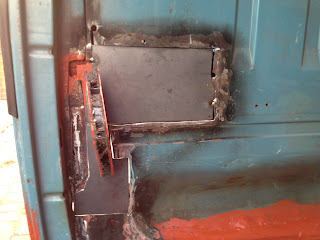I used a middle sill repair section with the sliding track from Alan Schofield which I welded in as straight and level as possible from front to back.
However when it came to putting the sliding door back on, whilst there was smooth rolling for 4 fifths of the travel, the closing piece of track was too high causing the door to jam.
It seems as though the track needs to drop down as the door moves in at the final section to re-engage with the striker plate.
I had to cut a section of the repair section out and use it as a template to cut a new piece in. This was shaped with a gentle curve to get a drop of around 8mm as the door closes.
The panel was tacked into place just enough to try the door out.
Only 2 pictures to show for this but plenty of taking the door off and on!
Once the position was confirmed as being good, it was welded in properly and painted out ready for the outer sill.


















































